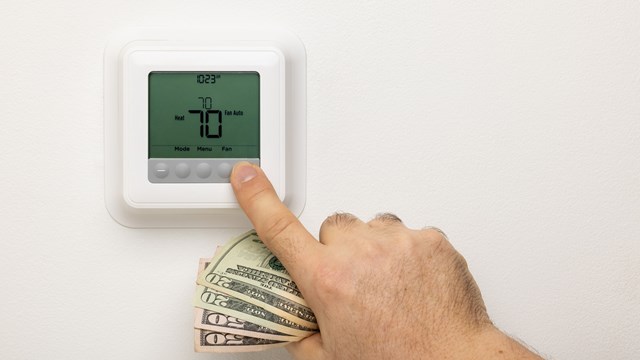
When people are charged for energy based on how much they use individually, good habits tend to follow. When you pay for electricity based on your usage, you're more likely to make sure that the lights are turned off when you leave a room, that you wash laundry in larger loads, and limit your air conditioning use even in the dog days of summer.
Many co-op and condo buildings buy energy in bulk, then charge owners a flat rate based on apartment size or shares owned. This can result in conservation-minded residents being unfairly charged for energy they don't use and lets wasteful users off the hook. Introducing submetering technology and "real time pricing" to a development may be one way to address the issue. The idea behind submetering and real time pricing is not only to bill shareholders fairly, but also to conserve energy, since people will be more cautious of their energy usage if they're billed for what they use, instead of a flat fee.
The populations of master-metered cooperatives, which constitute a great majority of New York City's housing stock, are more diverse today than when they were built 30, 40, 50 or even 60 years ago. Patterns of electricity consumption also have greatly changed, according to Lewis Kwit, president of Manhattan-based Energy Investment Systems. Shareholders and unit owners rely on many more electrical items such as dishwashers, computers, microwave ovens, VCRs, air filters, air conditioners, cable boxes, clocks, phones and faxes that may not have existed when their co-op or condo was built.
Cooperative boards, Kwit says, certainly recognize the fact that electric usage will continue to rise and so will their costs. People depend more and more on electricity to service their needs and as a result, those usage charges that feed into a board's budget may grow incrementally over the years if steps are not taken to incorporate some savings, according to Kwit.
Real time pricing (RTP), Kwit explains, allows consumers, in this case co-op and condo buildings, to buy power at a certain rate from the wholesale electric market, based on a fluctuating market price or when demand is less. If usage were reduced during peak demand, when prices are their highest, costs would then be lower on the wholesale market, and those costs would then trickle down to the electric user.
Incorporating real time pricing into the collective consciousness would encourage residents to shift their usage by making simple adjustments by operating appliances at off-peak hours, he says. Peak times can vary, but in general cover afternoons and early evenings. No one is expecting people to live in darkness during peak hours, but the idea is to encourage people to use certain items, such as dishwashers and vacuum cleaners, during off-peak hours. Weekends, for example, are considered off-peak.
To implement real time pricing requires a master metered building to be submetered. Submetering allows buildings that use a master meter to precisely measure the electricity each shareholder is using. A master-metered building has one electric meter that measures usage for the entire building, with the utility company sending one bill for the entire building's use. The building then collects fees from shareholders based on apartment size or shares owned. This allows buildings to be billed at a rate that's anywhere from 10 percent to about 25 percent lower than if the building is directly metered, meaning each apartment has a meter and every shareholder gets a bill from the electric company.
A submetered building has one master meter, as well as individual meters installed for each apartment. This allows the building to take advantage of the discounted rates energy providers offer customers for using master meters while allowing residents to pay only for the energy they use.
Kwit cites the case of 322 Central Park West, a 48-unit prewar building, that is experimenting with real time pricing as part of a pilot project last year through the New York State Energy Research and Development Authority (NYSERDA). The authority will typically cover half the installation cost of any submetering project, based on installing one meter into each apartment. In some cases, more than one meter may need to be installed. NYSERDA will also help buildings find firms that can install the submetering equipment.
Originally, 322 Central Park West had been master-metered and submetered and subsequently, Kwit says, all the meters had to be removed and a master meter from Con Edison installed. Interval meters, which measure individual usage, were then installed in all the apartments and in the common areas, Kwit adds. The building did not have to be rewired because that had been done previously, he says.
"The building receives electricity based upon the wholesale price, which can change hour-by-hour and day-by-day. As the new rates become part of people's consciousness, we expect that it will become second nature to use electric appliances when prices are low," according to Kwit. "During the first four months, price savings averaged 16 percent over conventional master-metered rates at the pilot building," he says, noting that some residents who have shifted their energy usage are saving more than 25 percent.
Another NYSERDA pilot project is underway at Clinton Hill, a 1,209-unit complex in Brooklyn, where Robert Friess, of American Metering & Planning Services Inc. of Smithtown, is the contractor. Friess explained that each building had been submetered and interval meters are being installed to allow real time pricing data to be collected.
According to NYSERDA, apartments are typically metered through electro-mechanical or electronic means. Some electro-mechanical meters, according to Friess, can be combined with an electronic data communications system, such as a powerline carrier or wireless data communications system that allows for the meters to be read remotely. If the electro-mechanical meter does not have the functionality of an electronic data communications system, it can only be read manually, NYSERDA states.
One drawback to installing a time-of-use or interval meter, is perhaps, cost, says Friess. These meters run about $600 or $700 versus an electro-mechanical meter that may cost only $50, he says. However, boards have to balance the installation costs against the potential cost savings they can achieve, he adds.
Buildings that are direct-metered, and thus have individual meters for each apartment can also save money, according to Friess.
"In buildings with individual meters, the building will purchase the energy from the utility in bulk, rather than each individual apartment buying energy. When submetering is installed in a directly metered building, the utility no longer bills each unit. It bills the whole property at the established bulk rate, which can be 18 to 25 percent less than the individual residential rate. Besides saving on energy costs, buildings that have 80/20 problems can use the funds collected for electrical usage to offset potential 80/20 revenue problems." Under Section 216 of the Internal Revenue Service Code, a co-op is required to derive 80 percent of its revenue from tenant/shareholders.
Herbert E. Hirschfeld, a professional engineer and consultant located in Glen Cove, has extensively analyzed the cost savings to residential buildings that choose to implement submetering programs. "There's no incentive for conservation [in master-metered buildings unequipped for submetering], because you're going to pay the same regardless of whether or not you conserve," Hirschfeld says.
"There's no incentive to purchase energy-efficient appliances, because your monthly charge for your air conditioner is going to be $20 whether it's energy-efficient or not. So why spend more on an energy-efficient model? If you submeter and you have to pay for what you use, there are real incentives to replace your appliances with energy-efficient ones." One report that Hirschfeld worked on determined that submetering results in an approximate reduction of electrical usage of 18 to 26 percent.
According to Hirschfeld, submetering was re-introduced in New York City in 1979 by the New York State Public Service Commission (PSC) after being banned in the mid-1950s. This was shortly after the energy crisis of the "˜70s and the search for ways to conserve energy. "The PSC recognized that submetering would promote conservation, since people would pay for the electricity they used, as opposed to paying a fixed amount based on the size of their apartment," Hirschfeld says.
The first step to retrofitting a building for submetering is getting approval from shareholders. After that, the board or management has to submit an application to the PSC. Hirschfeld says at minimum, it will take three months - and more likely around six - to get approval because of the PSC's backlog.
According to Hirschfeld, once all the "i's" are dotted and "t's" are crossed, you can expect to wait between 30 to 50 days for the equipment to be available. While the length of different jobs is certain to vary based on factors like apartment size and the number of electricians working on an apartment, a team of electricians should be able to submeter an average of 10 apartments a day, if they have to go into each apartment. "In some buildings with a dedicated breaker panel, they don't have to get into the apartments and can do a lot more in a day," Hirschfeld says.
Richard Angerame of Utility Programs and Metering, a Manhattan-based utility consulting group, says that boards and management companies need to be aware of the process and how many steps are involved. "You have to file for it. You need to file for the right rebates from NYSERDA, and you need to get the contractors."
Angerame says the long process can lead to frustration, and that's often when a consulting firm gets called. "You don't just want to have vendors coming off the street to do this," he says. "You want someone who understands the process and all the components and also someone who knows what rebates are available."
In order to benefit from NYSERDA's rebate, the meters a building purchases must have real-time billing capability, though buildings are not required to institute real-time billing at this point.
According to Hirschfeld, "The future goal is to [have] more buildings number one; submeter - so that at least they'll conserve from submetering - and number two, to submeter on a real-time pricing basis - which will shift the demand contribution from each building more off-peak hours and take the stress off the grid system."
Even beyond that, Hirschfeld says meters can be interfaced with other equipment to allow heating and air conditioning units to be turned off if usage gets too high.
"These residents can participate - on a voluntary basis - in a low-curtailment program that will enable them to share in the revenues that New York State makes available to buildings that participate in curtailment programs," Hirschfeld says.
While it's not known exactly how many New York City buildings are master-metered, submetering may not be the most practical option for every building. Since NYSERDA's program covers half the cost of one meter per apartment, installation of multiple meters where needed chips away at the appeal of the rebates.
"Some apartments require more than two meters," Hirschfeld says. "Some buildings have cross-wiring where somebody had an electrician come in and he wired something in Apartment A which a submeter would measure in Apartment B - that's something that might happen in an older building.
"There are cases where I wouldn't say it's impossible, but where the cost is significantly more, so that the measure becomes less attractive to the building. But for every 10 buildings I look at, I would only expect to find that in one or two."
There are other hurdles managers and boards can expect to encounter once they decide to introduce submetering to their building.
One of those is almost-certain resistance from the shareholders who will see an increase in their energy bills. Studies show that about 70 percent of a building's residents use about half of the electricity. In order for people who conserve energy to pay less, those who use the most electricity are going to pay more.
"I've been in situations where lawsuits have been initiated by shareholders opposed to the measure, though the co-ops have ultimately prevailed," says Hirshfeld. "In one case, the person who brought the matter to litigation turned out not only to be the highest user of electricity in the building, but used twice as much as the second-highest user. So it's understandable why that shareholder was opposed to the measure."
There are other obstacles as well - like fear of the unknown and apathy.
"We have a marketing effort where we're trying to get more building owners participate in this," says Ryan Moore, a spokesman for NYSERDA. "The problem we run into with co-op boards is that the main person driving these programs doesn't get re-elected. Or by the time it does get passed, somewhere along the line, someone with the board drops the ball and it's hard to get it going again. The main part of it is getting co-op boards to vote yes on it."
But in most cases, once a submetering program is implemented, about two out of three shareholders can expect to pay less per month in electricity bills. "It's been our experience that through submetering, multi-family buildings save anywhere from 18 to 26 percent on their energy bill," Moore says.
Some problems from the past have been solved. Hirschfeld says that when submetering was first installed years ago, large, unsightly meters had to be placed in apartments in most cases. The degree of rewiring was more difficult as well, but new technology is leveling the playing field and making it a more viable option for boards to consider.
"I would say submetering is probably the single-most controversial subject in any residential building," Hirschfeld says. "I've attended well over 100 meetings with different boards of directors and at least 25 to 50 meetings with shareholders and there's always a vocal minority that's opposed to the measure, and they tend to be more active than the majority that might be in favor."
Hirschfeld says he's even been at meetings where fistfights broke out between residents over the issue. But that doesn't mean communities shouldn't pursue submetering - conserving energy and saving money for a majority of residents are pretty good incentives. Just be sure to do your homework on the matter before proposing to overhaul your building's utility billing system at the next friendly board meeting - and you might also think about bringing a pair of boxing gloves.






Comments
Leave a Comment